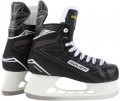The boot sizes of the skates. One skate model can have a full
fixed size grid (
25,
26,
27,
28,
29,
30,
31,
32,
33,
34,
35,
36,
37,
38,
39,
40,
41,
42,
43,
44,
45,
46 size) and include both
kids skates and adults. And for models with
adjustable sizes(see "More features"), size ranges are indicated in this paragraph, while one model can be produced in several range options. For example, the designation "35-38, 39-42" means that the skates are available in two versions: one is adjustable from size 35 to 37, the second is from 39 to 42.
A type of steel used in skate blades. Different grades of steel differ primarily in hardness and resistance to corrosion. In general, the harder the blades, the longer they last and the less often you have to sharpen them, but increasing the hardness reduces corrosion resistance and affects the cost. In addition, the quality of steel often depends not only on its type, but also on the price category of skates. Specific types can be:
—
Stainless. The most inexpensive and softest type of "skate" steel, which, however, can be used even in fairly advanced skates. Note that, despite the name, "stainless steel" is still not completely resistant to rust, and the blades still need to be wiped dry after use.
—
Alloy. Steel with special additives that improve hardness and some other properties. Somewhat harder than stainless steel and keeps sharpening longer, but it resists rust worse, is more demanding to care for, and is more expensive.
—
Carbon. Steel with a high carbon content is very hard and holds sharpening for a long time. On the other hand, such an alloy costs accordingly and requires careful maintenance, since it rusts easily from prolonged contact with moisture.
—
High carbon. Steel with a very high carbon content. The hardest and at the same time the most expensive variety, moreover, it is dif
...ficult to sharpen and sensitive to rust (however, in terms of the latter property, such steel almost does not differ from “ordinary” carbon steel).
